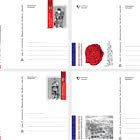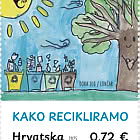Locomotives
Shunting locomotives are designed primarily for shunting wagons at train stations and marshalling yards. They were formerly used as industrial locomotives and for train haulage on open lines, which is something very rare these days. At present, there are two series of shunting locomotives running on Croatian railroads, namely diesel-hydraulic locomotives series HŽ 2132 and diesel-electric locomotives series HŽ 2041.
Diesel-hydraulic locomotive series HŽ 2132/JŽ 732
The HŽ 2132/JŽ 732 locomotives were built between 1969 and 1970 at the “Đuro Đaković” Factory in Slavonski Brod under license of the Austrian company Jenbacher Werke. The first locomotive was put into service on 15 October 1969. A total of 132 locomotives were built, 72 for the present-day Hrvatske željeznice railway company, 25 for the Slovenian railway company and 25 used for the purposes of industrial maneuvering. In 1977, another 10 locomotives of this series were commissioned by Hrvatske željeznice. Originally, these locomotives were equipped with a 441 kW (600 HP) Jenbach JW600 two-stroke diesel engine, a Voith L26St/v hydraulic transmission, a Voith N6 600/2 intermediate transmission, and a Voith A 30SK axle transmission.
Following 1975, the locomotives underwent gradual refurbishment and, since 1988, modernization. The modernization works included the installation of new Pielstick 6PA4V 184 VG and Jenbach JW 240 D four-stroke diesel engines, the installation of a new Voith L 3r4 turbo reversing hydraulic power transmission, as well as an upgrade of the cooling capacity of the front water cooler. As the result of the refurbishments and modernization, the sub-series of the locomotives 2132-000 (retaining the original power), 2132-100, 2132-200 and 2132-300 were created. Refurbishment and modernization works were carried out by TŽV “Gredelj“, the rolling stock factory from Zagreb, and other partners.
The installed power of the locomotive is 441 kW (600 HP), the tractive force is 397 kW (540 HP), the maximum speed reaches 30–60 km/h, the wheel diameter is 950 mm, the weight is 44 tons, the axle load is 14 tons and the length over the buffers is 10,500 mm.
Diesel-hydraulic locomotive series HŽ 2133/JŽ 734
Diesel-hydraulic locomotives of series HŽ 2133 were built between 1955 and 1964 at the German factory Maschinen Fabrik-Kiel AG. The locomotives are equipped with three drive shafts connected by rodes and hydraulic transmission, a built-in four-stroke diesel V engine with two cylinders connected to a common crankshaft. The transmission is located at the tail of the locomotive in the bogie and consists of hydraulic torque converter, driving mode converter and timetable converter.
In 1986, the Jugoslavenske željeznice railway company purchased a total of 15 used locomotives from the Deutsche Bahn, which were deployed at the railway administrations in Zagreb, Belgrade and Skopje. This included 10 German series V 260 locomotives (in the JŽ substructure series 0, in the HŽ substructure series 000) and five series V 261 locomotives (in the JŽ substructure series 1, in the HŽ substructure series 100). The series differed in the performance of the diesel engine. Due to their German origin, the locomotives obtained the popular name Švabice (Swabian girls).
Given that the locomotives were acquired as used, they soon underwent a complete refurbishment, during which the procurement of imported spare parts, in particular for the Maybach diesel engine, presented major problems. As a result, there was a proposal to replace the existing diesel engine with the domestic engine made by the Pielstick engine factory “Uljanik” from Pula, however, the re-motorization was never carried out. Today, the locomotives are no longer in active service.
The installed power of the 734 type V 260 locomotive is 478 kW (650 HP), and 511 kW (695 HP) for the type V 261. The tractive power of both locomotive types is 441 kW (600 HP), with a maximum speed range of 30–60 km/h and a wheel diameter of 1,250 mm. The weight of the V260 type locomotives is 48 tons and of the V 261 type 54 tons. The axle load of the type V 260 locomotive is 16 tons, and 18 tons for the type V 261. The length over the buffers on both locomotive types measures 10,450 mm.
Helena Bunijevac, prof.
Croatia - Recommended stamp issues
WOPA+ recommended stamp issues
| Avatar - Fire and Ash |
| Issued: 03.12.2025 |
| ›New Zealand |
| 50th Anniversary of the Founding of the 24th November Bar Scout |
| Issued: 24.11.2025 |
| ›Montenegro |
| Krisjanis Valdemars |
| Issued: 02.12.2025 |
| ›Latvia |
| Sign Language - Good |
| Issued: 02.12.2025 |
| ›Bosnia and Herzegovina - Republic of Srpska |
| In Memory of the Fallen and Murdered on October 7, 2023 |
| Issued: 08.10.2025 |
| ›Israel |
| Annual Collection Folder (New York) |
| Issued: 05.12.2025 |
| ›United Nations |
| Year Set |
| Issued: 24.11.2025 |
| ›Isle of Man |
| Shipping in the 17th and 18th Centuries - Peat Shipping |
| Issued: 05.12.2025 |
| ›Netherlands |











































